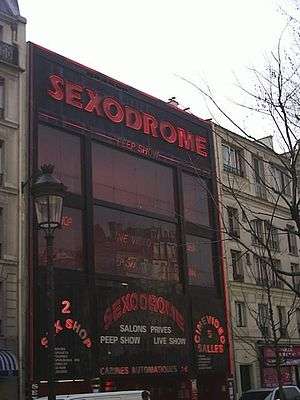Quartier Pigalle
Coordinates: 48°52′56.20″N 2°20′14.50″E / 48.8822778°N 2.3373611°E

Pigalle (French pronunciation: [pi.ɡal]) is an area in Paris around the Place Pigalle, on the border between the 9th and the 18th arrondissements. It is named after the sculptor Jean-Baptiste Pigalle (1714–1785).
Pigalle is famous for being a tourist district, with many sex shops, theatres and adult shows on Place Pigalle and the main boulevards. The neighbourhood's raunchy reputation led to its Second World War nickname of "Pig Alley" by Allied soldiers.[1] The Divan du Monde and the Moulin Rouge, a world-famous cabaret, are both located in Pigalle.
The area to the south of Place Pigalle is devoted to the retail of musical instruments and equipment, especially for popular music. A section of the rue de Douai consists solely of stores selling guitars, drums and musical accessories.
Henri Toulouse-Lautrec's studio was here. Artists such as Pablo Picasso, Vincent van Gogh and Maurice Neumont also once lived here as did Andre Breton, and in 1928 Josephine Baker opened her first night club next door to Breton's apartment. The works of artist Salvador Dalí can be seen at the nearby Espace Dalí.
It was also the home of the Grand Guignol theatre, which closed in 1962. However, the theatre building still stands.
Pigalle is well known to tourists who want to experience "Paris by night". It is home to some of Paris' most famous cabarets (the Moulin Rouge, for instance, was immortalised by artist Toulouse-Lautrec as well as Hollywood), as well as topless and nude shows.
Pigalle is one end-point of the Montmartrobus (a public bus serving the area), or you can get to the Place Pigalle by taking the Métro to the Pigalle stop.
American-born jazz singer Adelaide Hall lived in Pigalle in 1937–1938 and opened her nightclub La Grosse Pomme ("the Big Apple") at 73 Rue Pigalle.[2] Other nightclubs in Rue Pigalle during the late 1930s included the Moon Rousse and Caravan where Django Reinhardt played.[3]
In popular culture
- Georges Ulmer wrote the famous song Pigalle in 1946, and performed it himself.
- Maurice Chevalier wrote a song entitled Place Pigalle.
- Édith Piaf made an album titled La Rue Pigalle.
- Bill Ramsey sang a song entitled "Pigalle" in the 1961 German film de:Die Abenteuer des Grafen Bobby directed by Géza von Cziffra.
- The police comedy My New Partner (1984) is set in Pigalle.
- The film Pigalle (1994) was set in this district and starred Véra Briole and Francis Renauld.
- The American jazz singer Madeleine Peyroux's album Bare Bones (2009) contains a track entitled "Our Lady of Pigalle".
- The American pop band Sparks mentioned the district in the lyrics of "Sextown U.S.A.".
- The Amsterdam-based modern gypsy jazz band Pigalle44 was named after this district.[4]
- The French luxury shoe designer Christian Louboutin has named one of his shoe models "Pigalle".
- The French DJ DJ Snake released a track named "Pigalle" on his album "Encore" (2016).
- In Grand Theft Auto V, a classic French sports car is named the Pigalle.
- In 2017, Parisian pop group Therapie TAXI released a song entitled "Pigalle".
References
- ↑ Ben Cosgrove (October 14, 2014). "Madness, Torture, and Murder on a Paris Stage"". Time.
- ↑ Colin Bratkovich. Just Remember This. p. 146.
Big Apple Nightclub (La Grosse Pomme), 73 Rue Pigalle (owned and associated with Adelaide Hall...
- ↑ "Emile Savitry. Photographe" (in French).
Rue Pigalle et ses boîtes de nuit, Paris, 1938-1939, au premier plan La Lune Rousse, au centre La Roulotte où se produisait Django Reinhardt,
- ↑ "Reinier Voet & Pigalle44". Archived from the original on December 7, 2009. Retrieved December 29, 2009.